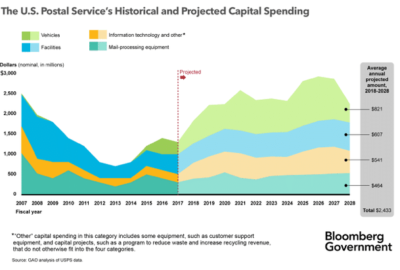 Exclusive
Exclusive  Exclusive
Exclusive Despite the surge in mail and packages from the holiday season and a bump in market mail leading up from last year's midterm elections, the Postal Service end...
Despite the surge in mail and packages from the holiday season and a bump in market mail leading up from last year’s midterm elections, the Postal Service ended the first quarter of fiscal 2019 worse off than the year before.
USPS reported a $1.5 billion loss for the first quarter of fiscal 2019, nearly $1 billion greater than the same period the previous year. The agency also reported slower growth in its package business, where it continues to compete with private-sector shippers.
The Postal Service saw its package business grow by 5.4 percent this quarter, equivalent to nearly 100 million packages. First-class mail, one of USPS’s most profitable products, declined by $81 million, or 1.2 percent.
Postmaster General Megan Brennan, in a conference call with reporters Friday, pointed to a “flawed business that was imposed on the Postal Service” as the root cause for continued net losses.
“What we can do on our end, clearly, is to continue to drive operating efficiencies, look at prioritizing our capital spend to offset labor costs,” Brennan said Friday.
Last month, the Postal Service implemented its highest-ever rate increase, raising the price of a first-class stamp from 50 cents to 55 cents. The rate increase also applies the USPS flat-rate letter and package products.
USPS estimates the rate increase will bring in about $891 million each year for its “market-dominant” products, which include letters and marketing mail, and an additional $870 million for its competitive services, including its package business.
The Postal Regulatory Commission approved the rate increase last year. Brennan said USPS sought the rate increase following a “rigorous analysis of the marketplace.”
“Like any business, we use [the] price lever to try to maximize profitable revenue. We know though, clearly, we need to ensure that we provide the service, the visibility and the value proposition,” she said.
Joe Corbett, the Postal Service’s chief financial officer, said USPS continues to see strong demand for its services, despite the rate increase, and that in the “medium-term,” the agency can retain mail volume, ensure its level of service and keep customers happy.
“We didn’t get too many calls from our customers thanking us for the price increase, but I think our customers do understand the value we’re delivering,” Corbett said.
Last December, the White House’s postal task force, chaired by Treasury Secretary Steve Mnuchin, released its recommendations to overhaul USPS’s business model.
While the task force report suggested rolling back postal unions’ collective bargaining rights over compensation, it didn’t look to undo the Postal Service’s obligation to pre-fund health benefits for future postal retirees — a hurdle USPS leadership and members of Congress have repeatedly sought to remove.
“The recommendations from the task force will be evaluated together with other proposed legislative and regulatory reform to address what I’ll describe as urgent financial challenges,” Brennan said.
National Association of Letter Carriers President Fredric Rolando, in a statement, said Congress should address the pre-funding mandate, which requires USPS to set aside about $5 billion each year to fund future retiree health benefits.
However, the Postal Service has defaulted on $43 billion in payments to the fund in recent years.
“It’s important to note that this goes on the books as red ink whether or not it’s actually paid in a given year,” Rolando said.
Postal officials have hinted at an upcoming Homeland Security and Governmental Affairs Committee hearing on the task force recommendations since last summer, when the task force gave President Donald Trump a closed-door briefing on its findings, but senators appear no more likely than before to review the postal reform recommendations.
A committee official, in an email Tuesday, said the committee doesn’t have any updates on a future postal reform hearing “at the moment.”
The Homeland Security and Reform Committee held a hearing last October, where members from both parties pushed back on the Trump administration’s short-lived proposal to privatize USPS.
Copyright © 2024 Federal News Network. All rights reserved. This website is not intended for users located within the European Economic Area.
Jory Heckman is a reporter at Federal News Network covering U.S. Postal Service, IRS, big data and technology issues.
Follow @jheckmanWFED
 Exclusive
Exclusive 